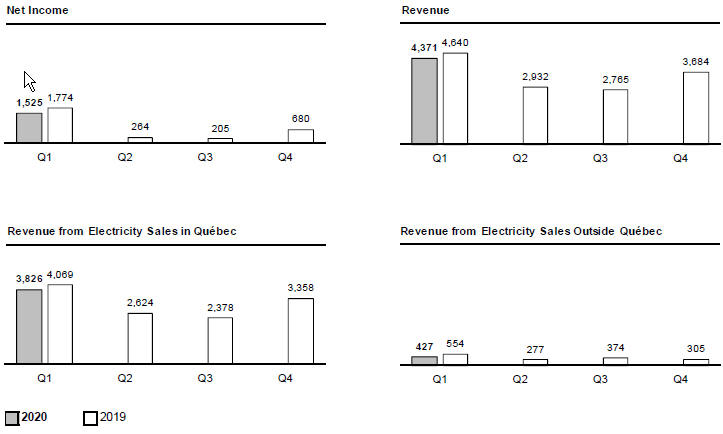| Note 7 | | Financial Instruments |
In the course of its operations, Hydro-Québec carries out transactions that expose it to certain financial risks, such as market, liquidity and credit risk. Exposure to such risks and the impact on results are reduced through careful monitoring and implementation of strategies that include the use of derivative instruments.
MARKET RISK
Market risk is the risk that the fair value or future cash flows of a financial instrument will fluctuate as a result of changes in market prices. Hydro-Québec is exposed to three main types of market risk: currency risk, interest rate risk and risk associated with energy and aluminum prices. Active integrated management of these three types of risk aims to limit exposure to each risk and reduce their overall impact on results.
MANAGEMENT OF LONG-TERM RISK
Management of risk associated with debt
Currency risk and interest rate risk – Hydro-Québec uses currency forward contracts and swaps to manage the currency risk associated with long-term debt and perpetual debt, as well as interest rate forward contracts and swaps to modify long-term exposure to interest rate risk. When designated as hedging items, these derivative instruments are recognized as cash flow hedges or fair value hedges, depending on the risk hedged. The impact on results of foreign currency hedging transactions and those associated with debt interest rates is recognized in Financial expenses.
The following table shows the notional amounts, expressed in Canadian dollars and foreign currencies, of forward contracts and swaps used to manage long-term risk:
| | | | | | | | |
| | | |
| | |
| As at March 31,
2020 |
a | |
| As at December 31,
2019 |
a |
| | |
Forward contracts | | | | | | | | |
| | |
Canadian dollars | | | (2,000 | ) | | | (1,900 | ) |
| | |
U.S. dollars | | | 201 | | | | 203 | |
| | |
Swaps | | | | | | | | |
| | |
Canadian dollars | | | (6,915 | ) | | | (6,893 | ) |
| | |
U.S. dollars | | | 5,730 | | | | 5,730 | |
| a) | Figures in parentheses represent amounts to be paid. |
MANAGEMENT OF SHORT-TERM RISK
Currency risk – Hydro-Québec uses forward contracts to manage its foreign currency risk exposure over the short term. When designated as hedging items, these derivative instruments are recognized as cash flow hedges. The impact of currency risk hedging transactions on results is recognized in the line items affected by the hedged item, namely Revenue, Electricity and fuel purchases, or Financial expenses. In this context, Hydro-Québec traded foreign currency sales and purchase contracts for which the notional amounts of open positions as at March 31, 2020, were US$1,980 million and US$2,327 million, respectively (US$1,542 million for sales contracts and nil for purchase contracts as at December 31, 2019).
Interest rate risk – Hydro-Québec uses interest rate forward contracts and swaps to manage short-term interest rate risk. When designated as hedging items, these derivative instruments are recognized as cash flow hedges. The impact on results of transactions to hedge short-term interest rate risk is recognized in the line item affected by the hedged item, namely Financial expenses.
Price risk – Hydro-Québec uses mainly commodity futures and swaps to manage risk resulting from fluctuations in energy and aluminum prices. When designated as hedging items, these derivative instruments are recognized as cash flow hedges. The impact on results of transactions to hedge the risk related to energy and aluminum prices is recognized in the line items affected by the hedged item, namely Revenue or Electricity and fuel purchases. In this context, Hydro-Québec traded electricity futures and swaps for which open positions as at March 31, 2020, totaled 22.4 TWh (23.4 TWh as at December 31, 2019), petroleum product swaps for which open positions as at March 31, 2020, totaled 22.1 million litres (22.3 million litres as at December 31, 2019), as well as aluminum swaps for which open positions as at March 31, 2020, totaled 187,575 tonnes (187,775 tonnes as at December 31, 2019). There were no natural gas futures with open positions as at March 31, 2020 (2.8 million MMBtu as at December 31, 2019).
| | |
| First Quarter 2020 | | Page 11 |

